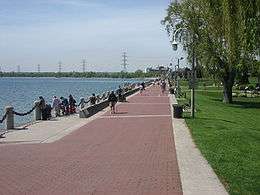Burlington, Ontario
| Burlington | |||
|---|---|---|---|
| City (lower-tier) | |||
| City of Burlington | |||
|
Spencer Smith Park on Burlington's waterfront | |||
| |||
| Motto: Stand By | |||
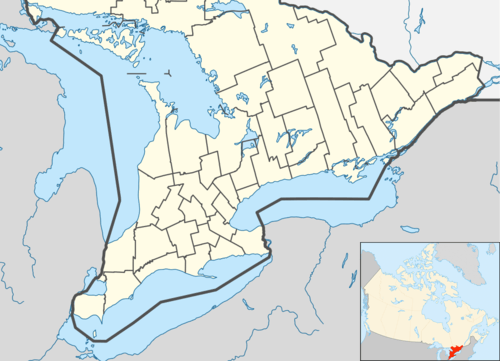 Burlington | |||
| Coordinates: 43°19′N 79°48′W / 43.317°N 79.800°WCoordinates: 43°19′N 79°48′W / 43.317°N 79.800°W | |||
| Country |
| ||
| Province |
| ||
| Region | Halton | ||
| Established | 1874 | ||
| City status | 1974 | ||
| Government | |||
| • Mayor | Rick Goldring | ||
| • Governing Body | Burlington City Council | ||
| • MPs | Karina Gould (Lib), Pam Damoff (Lib), Lisa Raitt (CPC) | ||
| • MPPs | Eleanor McMahon (OLP), Indira Naidoo-Harris (OLP) | ||
| Area[1] | |||
| • Total | 185.66 km2 (71.68 sq mi) | ||
| Elevation | 74 m (243 ft) | ||
| Population (2011)[1] | |||
| • Total | 175,779 (Ranked 28th) | ||
| • Density | 946.8/km2 (2,452/sq mi) | ||
| Time zone | Eastern (UTC−5) | ||
| • Summer (DST) | EDT (UTC−4) | ||
| Postal code | L7L - L7T | ||
| Area code(s) | 905, 289, 365 | ||
| Highways |
Former | ||
| Website | www.burlington.ca | ||

Burlington (Canada 2011 Census population 175,779), is a city in the Regional Municipality of Halton at the northwestern end of Lake Ontario. Along with Milton to the north, Burlington forms the west end of the Greater Toronto Area, while its metropolitan census area is part of the neighbouring city of Hamilton. Burlington lies between Lake Ontario's north shore and the Niagara Escarpment. Economically, Burlington is strategically located near the geographic centre of the Golden Horseshoe, a densely populated and industrialized region of over 8 million people.
History
.jpg)
Before pioneer settlement in the 19th century, the area was covered by the primeval forest that stretched between the provincial capital of York and the town of Hamilton, and was home to various First Nations peoples. In 1792, John Graves Simcoe, the first lieutenant governor of Upper Canada, named the western end of Lake Ontario "Burlington Bay" after the town of Bridlington in the East Riding of Yorkshire, England.[3] By the time land beside the bay was deeded to Captain Joseph Brant at the turn of the 19th century, the name "Burlington" was already in common use. With the completion of the local survey after the War of 1812, the land was opened for settlement. Early farmers prospered in the Burlington area because of the fertile soil and moderate temperatures. Produce from the farms was shipped out via the bustling docks of the lakeside villages of Port Nelson and Wellington Square, as well as Brown's Wharf in the nearby village of Port Flamborough (which was to become Aldershot). Lumber taken from the surrounding forests also competed for space on the busy docks. However, in the latter half of the 19th century, increased wheat production from Western Canada convinced local farmers to switch to fruit and vegetable production.
In 1874, Wellington Square and Port Nelson were incorporated into the Village of Burlington. However, the arrival of large steamships on the Great Lakes made the small docks of the local ports obsolete, and the increased use of railway to ship goods marked the end of the commercial wharves.
Farming still thrived though, and the resultant growth resulted in continued prosperity. By 1906, the town boasted its own newspaper—the Burlington Gazette—as well as a town library and a local rail line that connected Burlington to nearby Hamilton. During the First World War, 300 local men volunteered for duty in the Canadian Expeditionary Force—38 did not return. In 1915, Burlington was incorporated into a town.
As more settlers arrived and cleared the land, cash crops replaced subsistence farming. Gradually, mixed farming and market gardens became the dominant form of agriculture, and in the early 20th century the area was declared the Garden of Canada. The first peaches grown in Canada were cultivated in the Grindstone Creek watershed in the city's south-west part. The farming tradition has passed down through the generations. Today over forty percent of the Grindstone Creek watershed is still devoted to farms, orchards and nurseries.[4]
Following the Second World War, cheap electricity from nearby Niagara Falls and better transportation access due to the new (1939) Queen Elizabeth Way encouraged both light industry and families to move to Burlington. The population skyrocketed as new homes were built, encouraging developers to build even more new homes. On 1 January 1958, Burlington officially annexed most of the Township of Nelson, as well as Aldershot, formerly a part of East Flamborough Township. By 1967, the last cash crop farm within the city had been replaced by the Burlington Mall.[5]
By 1974, with a population exceeding 100,000, Burlington was incorporated as a city. The extremely high rate of growth continued, and between 2001 and 2006, the population of Burlington grew by 9%, compared to Canada's overall growth rate of 5.4%. By 2006, the population topped 160,000. Continued high rates of growth are forecast as farmland north of Dundas Street (former Highway 5) and south of Highway #407 is developed into more suburban housing.
Geography and climate
Burlington is at the southwestern end of Lake Ontario, just to the north of Hamilton and the Niagara Peninsula, roughly in the geographic centre of the urban corridor known as the Golden Horseshoe. Burlington has a land area of 187 km2 (72 sq mi). The main urban area is south of the Parkway Belt and Hwy. 407. The land north of this, and north Aldershot is used primarily for agriculture, rural residential and conservation purposes. The Niagara Escarpment, Lake Ontario and the sloping plain between the escarpment and the lake make up the land area of Burlington. The city is no longer a port; sailing vessels in the area are used for recreational purposes and moor at a 215 slip marina in LaSalle Park. The 2.2 km long Skyway Bridge is a prominent landmark.
Burlington’s climate is humid continental (Köppen climate classification Dfa) with warm, humid summers and cold, somewhat drier winters. The climate is moderated by its proximity to Lake Ontario. Monthly mean temperatures range from 22.3 °C (72.1 °F) in July to −4.2 °C (24.4 °F) in January. The average annual precipitation is 878 millimetres (34.6 in) of rain and 109 centimetres (43 in) of snow.
Although it shares the temperate climate found in Southern Ontario, its proximity to Lake Ontario moderates winter temperatures and it also benefits from a sheltering effect of the Niagara Escarpment, allowing the most northerly tracts of Carolinian forest to thrive on the Escarpment that runs through western sections of city. Several species of flora and fauna usually found only in more southern climes have their only Canadian presence here including paw-paw, green dragon (Arisaema dracontium), tuckahoe (Peltandra virginica), American columbo (Frasera carolinensis), wall-rue (Asplenium ruta-muraria), plus the Louisiana waterthrush, the hooded warbler, the southern flying squirrel and the rare eastern pipistrelle. Near the visible promontory of Mount Nemo that rises some 200 m (650 ft) above the lake level, a "vertical forest" of white cedar clinging to the Escarpment face includes many small trees that are more than a thousand years old.[6]
Hamilton Harbour, the western end of Lake Ontario, is bounded on its western shore by a large sandbar, now called the Beach strip, that was deposited during the last ice age. A canal bisecting the sandbar allows ships access to Hamilton Harbour, which lies behind the sandbar. The Burlington Bay James N. Allan Skyway (part of the Queen Elizabeth Way), and the Canal Lift Bridge allow access over the canal.
| Climate data for Burlington (1981–2010) | |||||||||||||
|---|---|---|---|---|---|---|---|---|---|---|---|---|---|
| Month | Jan | Feb | Mar | Apr | May | Jun | Jul | Aug | Sep | Oct | Nov | Dec | Year |
| Record high °C (°F) | 15.0 (59) |
18.0 (64.4) |
27.0 (80.6) |
32.0 (89.6) |
35.0 (95) |
37.2 (99) |
39.0 (102.2) |
37.2 (99) |
36.1 (97) |
31.1 (88) |
26.7 (80.1) |
22.0 (71.6) |
39.0 (102.2) |
| Average high °C (°F) | −0.6 (30.9) |
0.8 (33.4) |
5.2 (41.4) |
12.4 (54.3) |
19.4 (66.9) |
25.0 (77) |
28.0 (82.4) |
26.7 (80.1) |
21.8 (71.2) |
15.1 (59.2) |
8.0 (46.4) |
2.4 (36.3) |
13.7 (56.7) |
| Daily mean °C (°F) | −4.4 (24.1) |
−3.2 (26.2) |
1.0 (33.8) |
7.5 (45.5) |
13.9 (57) |
19.4 (66.9) |
22.5 (72.5) |
21.4 (70.5) |
16.9 (62.4) |
10.4 (50.7) |
4.4 (39.9) |
−1 (30) |
9.1 (48.4) |
| Average low °C (°F) | −8.1 (17.4) |
−7.1 (19.2) |
−3.3 (26.1) |
2.6 (36.7) |
8.3 (46.9) |
13.8 (56.8) |
16.9 (62.4) |
16.1 (61) |
11.9 (53.4) |
5.7 (42.3) |
0.7 (33.3) |
−4.3 (24.3) |
4.4 (39.9) |
| Record low °C (°F) | −29.4 (−20.9) |
−27 (−17) |
−23.9 (−11) |
−13.9 (7) |
−2.8 (27) |
1.1 (34) |
5.6 (42.1) |
3.0 (37.4) |
−1.1 (30) |
−7.8 (18) |
−16.1 (3) |
−27 (−17) |
−29.4 (−20.9) |
| Average precipitation mm (inches) | 66.0 (2.598) |
54.5 (2.146) |
61.6 (2.425) |
70.6 (2.78) |
81.0 (3.189) |
69.1 (2.72) |
75.3 (2.965) |
82.0 (3.228) |
83.1 (3.272) |
71.9 (2.831) |
84.9 (3.343) |
63.0 (2.48) |
863.1 (33.98) |
| Average rainfall mm (inches) | 31.8 (1.252) |
33.0 (1.299) |
44.7 (1.76) |
68.2 (2.685) |
81.0 (3.189) |
69.1 (2.72) |
75.3 (2.965) |
82.0 (3.228) |
83.1 (3.272) |
71.9 (2.831) |
79.7 (3.138) |
43.5 (1.713) |
763.3 (30.051) |
| Average snowfall cm (inches) | 34.2 (13.46) |
21.5 (8.46) |
16.9 (6.65) |
2.4 (0.94) |
0.0 (0) |
0.0 (0) |
0.0 (0) |
0.0 (0) |
0.0 (0) |
0.0 (0) |
5.3 (2.09) |
19.5 (7.68) |
99.9 (39.33) |
| Average precipitation days (≥ 0.2 mm) | 12.4 | 9.6 | 11.0 | 12.5 | 11.8 | 10.9 | 10.1 | 10.2 | 10.9 | 10.7 | 13.9 | 11.9 | 135.8 |
| Average rainy days (≥ 0.2 mm) | 4.9 | 4.5 | 8.0 | 11.7 | 11.8 | 10.9 | 10.1 | 10.2 | 10.9 | 10.7 | 12.7 | 7.7 | 113.9 |
| Average snowy days (≥ 0.2 cm) | 8.1 | 6.0 | 3.6 | 0.84 | 0.0 | 0.0 | 0.0 | 0.0 | 0.0 | 0.0 | 1.6 | 5.4 | 25.5 |
| Source: Environment Canada[7] | |||||||||||||
Demographics
| Burlington | ||
|---|---|---|
| Year | Pop. | ±% |
| 1901 | 1,119 | — |
| 1911 | 1,831 | +63.6% |
| 1921 | 2,709 | +48.0% |
| 1931 | 3,046 | +12.4% |
| 1941 | 3,815 | +25.2% |
| 1951 | 6,017 | +57.7% |
| 1961 | 47,008 | +681.3% |
| 1971 | 87,023 | +85.1% |
| 1981 | 114,853 | +32.0% |
| 1991 | 129,575 | +12.8% |
| 1996 | 136,976 | +5.7% |
| 2001 | 150,836 | +10.1% |
| 2006 | 164,415 | +9.0% |
| 2011 | 175,779 | +6.9% |
Age
According to the 2011 census, Burlington's population was 175,779. As of the 2006 census, 48% of residents were male and 52% female. Minors (individuals under the age of 18) made up 24.5% of the population (almost identical to the national average of 24.4%), and pensioners (age 65+) numbered 15.4% (significantly higher than the national average 13.7%). This older population was also reflected in Burlington's average age of 40.3, which was higher than the Canadian average of 39.5.[8]
Race and ethnic origins
| Ethnic Origin[9] | Population | Percent |
|---|---|---|
| English | 59,330 | 36.51% |
| Scottish | 39,605 | 24.37% |
| Irish | 33,855 | 20.83% |
| German | 16,640 | 10.24% |
| French | 15,980 | 9.83% |
| Italian | 11,430 | 7.03% |
| Dutch | 8,575 | 5.27% |
| Polish | 8,120 | 5.00% |
As recorded in the same census, 91.04% of the population was white. Other groups include South Asian: 3.1%, mixed race: 1.5%, black: 1.5%, and Chinese: 1.3%.[10]
The top eight ethnic origins from the 2006 census are listed in the accompanying table. Percentages add up to more than 100% because respondents were able to choose more than one ethnicity.
Language
According to the 2011 Census,[11] English is the mother tongue for 80.7% of the residents of Burlington, followed by French (1.8%), Polish (1.3%), Spanish (1.2%), German (1.1%) and Italian (1.1%). However, Statistics Canada warned that "data users are advised to exercise caution when evaluating trends related to mother tongue and home language that compare 2011 census data to those of previous censuses," due to the discontinuation of the mandatory long census form by the federal government.[12]
Religion
In the 2001 Canadian census, 78% of Burlington residents identified themselves as Christian. Of these, approximately 41% claimed adherence to one of the mainstream Protestant churches or were Anglican, 32% were Roman Catholic, and the remaining 27% belonged to other denominations such as the Church of Jesus Christ of Latter Day Saints (Mormons), the Ukrainian Catholic Church, and various Orthodox denominations.[13] Of the remaining 22% of the population that did not identify themselves as Christian, 16.6% identified themselves as following no religion, 1.0% were Muslim, 0.7% Sikh, 0.5% Hindu, 0.4% Jewish, 0.3% Buddhist, and 0.1% Pagan.[13]
Economy
Burlington's economic strength is the diversity of its economic base, mainly achieved because of its geography, proximity to large industries in southern Ontario (Canada's largest consumer market), its location within the Greater Toronto and Hamilton Area (GTHA) and proximity to Hamilton, and its transportation infrastructure. This diversity has allowed for sustained growth with regards to the economy.[14] The city has a robust economy with potential for future growth - it is located at the hub of the Golden Horseshoe, is largely driven by both the automotive and manufacturing sectors. The city has historically been a destination with a high quality of life, being most recently named the 2nd best city in Canada in which to live.[15]
No single employer or job sector dominates Burlington’s economy. The leading industrial sectors, in terms of employment, are food processing, packaging, electronics, motor vehicle/transportation, business services, chemical/pharmaceutical and environmental. The top five private sector employers in Burlington are Fearmans Pork Inc, Cogeco Cable, Evertz Microsystems, Boehringer Ingelheim and EMC2. Other notable business include The EBF Group, ARGO Land Development, and The Sunshine Doughnut Company.[16] [17]The largest public sector employers in the city are the City of Burlington, the Halton District School Board, the Halton Catholic District School Board and Joseph Brant Hospital.
The Burlington Mall and Mapleview Centre are popular malls within the city. The many summer festivals in the city, include Canada's Largest Ribfest, and the Burlington Sound of Music Festival which also attract many visitors.
Media and journalism
Television stations
Burlington is primarily served by media based in Toronto (other than those noted below), as it is geographically located in the Greater Toronto and Hamilton Area (GTHA).
- TVCogeco from the studio in the Cogeco Cable Headquarters at Harvester Road & Burloak Drive.
- Yes TV is based in Burlington with studios on the North Service Road near the junction of the QEW, 403 and 407.
- Hamilton based Television station CHCH-TV serves Hamilton, Halton and Niagara, thus including Burlington.
Radio
One radio station, FM 107.9 CJXY, is licensed to Burlington and another, FM 94.7 CHKX, to "Hamilton/Burlington." Both presently broadcast from studios in Hamilton; CJXY, indeed, brands itself "Hamilton's ONLY Rock Station." Burlington listeners are also served by stations licensed to Toronto and Hamilton and other nearby radio markets like Buffalo, NY.
Print media
The following publications are either published in or around Burlington, or have Burlington as one of their main subjects:
- Burlington Post
- Snap Burlington
- View Magazine
- Burlington News
Education
Burlington's public elementary and secondary schools are part of the Halton District School Board. Burlington's Catholic elementary and secondary schools are part of the Halton Catholic District School Board. French public elementary and secondary schools are part of the Conseil scolaire Viamonde and French catholic elementary and secondary schools are part of the Conseil scolaire de district catholique Centre-Sud (CSDCCS). Several private schools are also available in the city.
Elementary schools
There are 29 public elementary schools and 14 Roman Catholic elementary schools in Burlington.
High schools
There are eight public high schools and three Catholic high schools in Burlington.
Public
- Aldershot School (1964) Sports Team: Lions
- Burlington Central High School (1922) Sports Team: Trojans
- Frank J. Hayden Secondary School (2013) Sports Team: Huskies
- Gary Allan High School Burlington Campus - Adult Learners School
- Lester B. Pearson High School (1977) Sports Team: Patriots
- M.M. Robinson High School (1963) Sports Team: Rams
- Nelson High School (1957) Sports Team: Lords
- Robert Bateman High School (2004) Sports Team: Wild
Catholic
- Assumption Secondary School (1977) Sports Team: Crusaders
- Corpus Christi Catholic Secondary School (2008) Sports Team: Longhorns
- Notre Dame Secondary School (1989) Sports Team: Fighting Irish
Private
There are 13 private schools in Burlington.
Universities
- McMaster University DeGroote School of Business - Ron Joyce Centre opened in September 2010 and offers MBA and Executive Management programs.[18]
- Australian university Charles Sturt University has had a study centre in Burlington since 2005 and offers programs in Master of International Education, Bachelor of Early Childhood Studies and Master of Business Administration. .[19]
Colleges
- Canadian Therapeutic College (affiliate of the Canadian College of Dental Health).
- Oxford College of Arts, Business and Technology
Transportation
Burlington Transit, the public transport provider in the city, provides service on a transportation grid centred on three commuter GO Train stations: Appleby, Burlington and Aldershot.
Major transportation corridors through the city include the Queen Elizabeth Way, Highway 403, Highway 407, and Dundas Street (former Highway 5). Commuter and travel rail service is provided by both GO Transit and Via Rail. Rail cargo transportation is provided by both Canadian National Railway and Canadian Pacific.
On 26 February 2012, a Via Rail train traveling from Niagara Falls to Toronto Union Station derailed in Burlington, with three fatalities.[20]
Politics
.png)
Local government
The city is divided into six wards, each represented by a city councillor. The mayor, who chairs the city council, is Rick Goldring.
Council elected for 2014–2018[21]
- Mayor: Rick Goldring
- Ward 1: Rick Craven
- Ward 2: Marianne Meed Ward
- Ward 3: John Taylor
- Ward 4: Jack Dennison
- Ward 5: Paul Sharman
- Ward 6: Blair Lancaster
Federal
Federally, the city is represented by three MPs whose ridings cover parts of the city:
- Burlington (covers most of the city): Karina Gould, Member of Parliament (Liberal)
- Milton (the mainly rural countryside north of Highway 407): Lisa Raitt (Conservative)
- Oakville North-Burlington (the area bounded by Highway 407 to the north, Dundas Street to the south, Guelph Line to the west and Oakville to the east): Pam Damoff (Liberal)
Provincial
Provincially, the city is represented by two MPPs, whose ridings were geographically contiguous with their federal counterparts before federal electoral redistribution in 2015. (Current provincial ridings will be re-distributed to match current federal ridings for the scheduled provincial election in 2018):[22]
- Burlington: Eleanor McMahon (Liberal)
- Halton: Indira Naidoo-Harris (Liberal)
Recreation and sites of interest
There are 115 parks and 580 ha of parkland in the city.
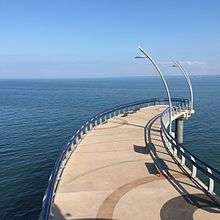
On the shore of Lake Ontario, Spencer Smith Park features an expansive shoreline walking path. The park is newly renovated, with an observatory, outdoor pond, water jet play area and restaurant. Many annual free festivals take place in Spencer Smith Park, including Canada's Largest Ribfest and the Sound of Music Festival, Canada Day, Children's Festival and Lakeside Festival of Lights. There is also the semi-annual prix fixe Taste of Burlington dining event.
The Brant Street Pier opened in Spencer Smith Park during the Sound of Music Festival on Father’s Day weekend, 2013.[23] Thousands of people from Burlington and beyond flocked to the pier to enjoy sunshine and scenic views. The pier extends 137 metres over Lake Ontario and provides views of the lake and Burlington’s shoreline.
The Art Gallery of Burlington is adjacent to Spencer Smith Park, and contains diverse permanent and changing exhibits. The Gallery houses a prominent collection of Canadian ceramics. The Gallery’s exhibition spaces, which feature new exhibitions every eight to ten weeks, are fully accessible and are free to visitors.[24]
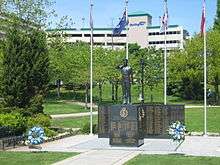
"Royal Canadian Naval Association Naval Memorial (1995)" by André Gauthier is a 6’4” high cast bronze statue of a WWII Canadian sailor in the position of attention saluting his lost shipmates, which was erected in Spencer Smith Park. The model for the statue was a local Sea Cadet wearing Mike Vencel's naval service uniform.[25] On the black granite base, the names of Royal Canadian Navy and Canadian Merchant Marine ships sunk during WWII are engraved. On the granite wall, the names of all Royal Canadian Navy ships and Canadian Merchant Marine vessels which saw service in WWII are engraved.[26] A monument commemorating the Korean War was erected in the summer of 2014 to mark the 61st anniversary of the armistice to end the war.[27]
Burlington is home to the Royal Botanical Gardens, which has the world’s largest lilac collection. Ontario's botanical garden and National Historic Site of Canada features over 2,700 acres (11 km2) of gardens and nature sanctuaries, including four outdoor display gardens, the Mediterranean Garden under glass, three on-site restaurants, the Gardens' Gift Shop, and festivals.
Lasalle Park, in the Burlington neighbourhood of Aldershot, is owned by the city of Hamilton but is leased by Burlington, which also assumes responsibility for maintenance.
Several conservation areas are minutes away and feature year round activities. Mount Nemo Conservation Area is the only area in Burlington that is operated by Conservation Halton. Bronte Creek Provincial Park is along the eastern boundary of the city and features a campground and recreational activities and events year-round.
The local sections of the Bruce Trail and the Niagara Escarpment, which is a UNESCO designated World Biosphere Reserve, provide excellent hiking opportunities. Kerncliff Park, in an abandoned quarry on the boundary with Waterdown, is a naturalized area on the lip of the Niagara Escarpment. The Bruce Trail runs through the park, at many points running along the edge of the cliffs, providing a clear overlook of Burlington, the Burlington Skyway Bridge, Hamilton, and Oakville. On a clear day, one can see the CN Tower in Toronto, approximately 50 kilometres (31 mi) from the park.
The Joseph Brant Museum and Ireland House are also popular attractions. Joseph Brant Museum has ongoing exhibits on the history of Burlington, the Eileen Collard Costume Collection, Captain Joseph Brant and the visible storage gallery. Ireland House at Oakridge Farm is a history museum depicting family life from the 1850s to the 1920s.
Burlington offers four indoor and two outdoor pools, four splash pads, nine ice pads, four community centres and nine golf courses. The Appleby Ice Centre is a 4-pad arena, used year-round for skating and ice hockey.[28]
The Burlington Performing Arts Centre opened in 2011. This 940-seat facility is on Locust Street in the downtown core. It contains two theatres for theatrical and musical performances.[29]
Malls and shopping
- Appleby Mall - a mall at Appleby Line and New Street. The mall has been recently renovated as an outdoor box store centre.
- Burlington Mall - a one-storey mall at Guelph Line and Fairview Street, opened in 1968, with several renovations completed at various intervals over the years.
- Mapleview Centre - a two-storey mall, opened in 1990, with many upscale and destination stores Banana Republic, Guess?, XXI Forever, H&M, Bath & Body Works and Pink by Victoria's Secret) at Queen Elizabeth Way and Fairview Street, recently expanded in the Fall of 2009 with GUESS by Marciano, Zara, Coach, Aritzia and Sephora.

 City Hall, on Brant Street
City Hall, on Brant Street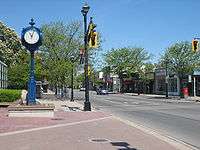 Brant Street, downtown
Brant Street, downtown Joseph Brant Memorial Hospital, downtown
Joseph Brant Memorial Hospital, downtown
Organizations
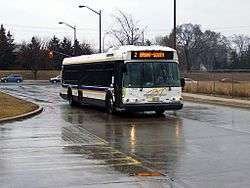
The Burlington Teen Tour Band has operated in the city since 1947, including members between the ages of 13 and 21. The marching band goes by the nickname The Redcoats due to the colour of its uniforms, and are regular participants in major international parades. They are also referred to as "Canada's Musical Ambassadors" and have represented Canada all over the world. One such occasion was during the 2008 Tournament of Roses Parade, where the band represented Canada for the fourth time in the band's history. The band is currently led by Rob Bennett, managing director, along with Sir William Hughes, musical director.
The Junior Redcoats are the younger version of the Teen Tour Band. The band includes children between the ages of 9 to 12. The Junior Redcoats' major performances are most commonly at the Burlington Santa Claus Parade, the Waterdown Santa Claus Parade, Hamilton Place (along with the Teen Tour Band) and the Sound of Music Parade. The Junior Redcoats are currently directed by Bill Rolfe.
The Burlington Concert Band has been in operation since 1908. The band, composed of local volunteer musicians, plays a wide variety of musical styles and repertoire. It primarily performs to raise money for charitable causes. The Burlington Concert Band is a participating member of Performing Arts Burlington as well as the Canadian Band Association. The band maintains an open membership policy, allowing anyone who feels they can handle the music competently to join without an audition. Its primary venue has been the Burlington Performing Arts Center since it opened in 2011. The Burlington Concert Band is currently directed by Zoltan Kalman and led by an elected board currently headed by Jane Lemke.
Since 1961, 715 "Mohawk" Squadron of the Royal Canadian Air Cadets has been a fixture in the city. The Royal Canadian Air Cadets is only one of the three branches of the Canadian Cadet Movement. The CCM is a partnership between the Department of National Defence, and each of the three cadet leagues: The Air Cadet League of Canada, The Army Cadet League of Canada, and the Navy League. The CCM is the largest federally funded youth program in Canada, and is open to youth ages 12–18 who are interested in leadership, citizenship, physical fitness, the Canadian Forces, and personal discipline. The Army Cadet Corps is 2379 Royal Hamilton Light Infantry Army Cadet Corps.
Burlington Area Scout traces its organization back to 1910 when the town's population was about 1,000. The first local Scoutmaster was Archie McGibbon, who remained in his position for more than a year, after which there was a succession of leaders including Hughes Cleaver and William Gilbert. The original enrolment of 25 boys was considered excellent for the small population of Burlington.
In approximately 1918, Rev. George W. Tebbs took over the troop. It was in the 1920s when Scoutmaster Tebbs and the local troop met Robert Baden-Powell in Burlington. The founder was motoring to Toronto and broke his trip for a short while when he saw the Scouts lined up at Gore Park on the waterfront. For many years, Rev. Tebbs led the boys as they marched out of town, hauling the trek cart to a distant camping location. It wasn't until 1958 that the Scouts' combined group committees were able to buy the 90-acre (360,000 m2) camping grounds in North Burlington at Camp Manitou.
The current Burlington Area Scouts came into existence in 1958 as "Burlington District" with amalgamation of several groups from Burlington and surrounding area. There are 17 active groups within the Area, providing Scouting to over 700 members. The Area stretches outside the city limits of Burlington and encompasses the additional communities of Waterdown, Kilbride, and Carlisle.[30]
Sports
Local teams
Burlington Cougars—formerly the Burlington Mohawks—are an Ontario Provincial Junior A Hockey League Team.
The following are the names associated with Burlington sport teams:
- Burlington Lions Optimist Minor Hockey Association
- Burlington Barracudas Girls Hockey Teams
- Burlington Skyway Roller Derby
- Burlington Track and Field Club
- Burlington Chiefs Lacrosse Teams
- Burlington Eagles Hockey Teams
- Burlington Stampeders Football Teams
- Burlington Basketball Basketball Teams
- Burlington Bulls Baseball Teams
- Burlington Haganites Water Polo Team
- Burlington Organized Minor Baseball Association (BOMBA) Baseball Teams
- Burlington Centaurs Rugby Teams
- Burlington Blaze Girls Volleyball Teams
- Burlington Bandits Girls Softball Teams
- Burlington Braves Football Team
- Burlington Blast Ringette Team
- Burlington Bandits Baseball Team
- Burlington Bayhawks Soccer Teams
- Burlington Cougars Hockey Teams
The Burlington Soccer League is the organization behind most men's league soccer in Burlington. The Burlington Youth Soccer Club is the second-largest youth soccer club in North America, after the Oakville Youth Soccer Club. Soccer Club Organization of Burlington Youth (Scooby Soccer) is a unique youth soccer club with ties to DPS ACADEMY.
NEXXICE is a synchronized skating team associated with the Burlington Skating Club (and the Kitchener Waterloo Skating Club). They are the reigning Canadian Senior champions, and were the first (and only) Canadian team to win a world championship.
An ill-fated proposal existed to move the Hamilton Tiger-Cats to Burlington as part of a stadium construction plan in conjunction with a bid for the 2015 Pan Am Games.[31]
International competition
Also, Burlington, Ontario founded the Burlington International Games (B.I.G.). The games were first held in 1969 " to offer an athletic and cultural exchange experience for the youth of Burlington." Until recently, the games took place between Burlington, Ontario and Burlington, Vermont, United States. But, other cities from places such as Quebec, Japan, the Netherlands, and the U.S. have all had athletes compete since 1998.[32] The games celebrated their 40th anniversary in 2009 and this competition ceased in 2010 due to limited participation in recent years.

Notable people
Artists and writers
- Chris Bacon, avian painter.
- Margaret Lindsay Holton, (1955- ), artist, author, and designer.
- Sylvia McNicoll, (1954- ), author of over twenty novels for children and young adults
- Kelly Richardson, (1972- ), artist, born in Burlington.
- James Sidney, author and environmentalist.
- Robert Bateman, (1930- ), painter.
Music
- James Anthony - (1955-), USA Hall of Fame Blues Guitarist.
- Boys Night Out - rock band.
- The Creepshow, psychobilly band
- Jeff Danna - (1964-), film music composer.
- Dead and Divine - metal / hardcore band
- Finger Eleven - alternative rock band; all attended Lester B. Pearson High School
- Grade - rock band
- Sarah Harmer - (1970-), singer and songwriter; attended Lester B. Pearson High School
- Jordan Hastings, (1982-), Alexisonfire, drummer
- Idle Sons - rock band; attended Lester B. Pearson, Aldershot and M.M. Robinson High Schools
- Jersey - (1995–2005), ska punk band
- Melissa McClelland - (1979-), singer and songwriter.
- Devraj Patnaik - (1975-), music composer, odissi dancer and choreographer
- Ripped - alternative rock band
- Saint Alvia, punk rock band
- Silverstein - post-hardcore band
- Spoons - 1980s new wave band
- Tebey - (1983-), country music artist, attended Assumption Secondary School
- Walk Off the Earth - (2006-), alternative rock band
Sports
- Steve Bauer, (born 1959), road bicycle racer; Olympic Silver Medalist (1984 Los Angeles Games); competed in 11 Tours de France, one of only two Canadians to wear the Yellow jersey; born in St. Catharines but resides in Burlington.
- Ryan Bomben (born 1987), current offensive guard for the Hamilton Tiger Cats of the Canadian Football League.
- Melanie Booth (born 1984), soccer player (Canadian Soccer Association, Florida Gators NCAA)
- Cory Conacher (born 1989), NHL player, Buffalo Sabres, New York Islanders.
- Angela Coughlan (1953–2009), swimmer, winner of a bronze medal at the 1968 Olympic Games; a gold, two silvers and a bronze at the 1970 British Commonwealth Games; a gold and three silvers at the 1971 Pan American Games.
- Adam Creighton (born 1965), retired professional hockey player who played 708 NHL games.
- Tony Gabriel (born 1948), retired CFL tight end with the Ottawa Rough Riders and Hamilton Tiger-Cats. 8-time CFL all-star, league MVP 1978, twice winner of the Grey Cup.
- Graham Hood (born 1972), competitive middle distance runner, Olympian, Pan Am Games champion; Born in Winnipeg but raised in Burlington. Competed at 1992 Olympics (Barcelona) and 1996 Olympics (Atlanta). Gold medallist, 1500 m, at 1999 Pan Am Games (Winnipeg).
- Russ Jackson, retired CFL quarterback, has lived in Burlington since his retirement from teaching.
- Jesse Lumsden (born 1982), running back with the Edmonton Eskimos and the Hamilton Tiger Cats of the Canadian Football League and Canadian Olympian in the Men's Two and Four-Man Bobsleigh at the Vancouver 2010 Olympics; attended Nelson High School.
- David Matsos (born 1973), former AHL hockey player; current assistant coach of the Windsor Spitfires
- Trevor Meier (born 1973), former Swiss Nationalliga 'A' Hockey Player, various clubs 1993-2012; born in Oakville, raised in Burlington, currently resides in Switzerland.
- Andy O'Brien (born 1979), Irish soccer player, Star Striker of the 2004-2005 UCD Super League Champions, Surprise X Saint Germain.
- Mark Oldershaw (born 1983), Canadian sprint canoeist who competed at the 2008 Olympics (Beijing) and won a bronze medal in C-1 1000 m at the 2012 Olympics (London)
- Dave Ridgway (born 1959), placekicker, Saskatchewan Roughriders CFL 1982-1996. Attended M.M. Robinson High School. Inducted into Canadian Football Hall of Fame in 2003. Played NCAA football for the University of Toledo Rockets 1977–1980.
- Melville Marks Robinson (1888–1974), founder of the Commonwealth Games.
- Chris Schultz (born 1960), former offensive tackle with the NFL Dallas Cowboys and CFL Toronto Argonauts, and current TSN sportscaster; attended Aldershot High School
- Chad Wiseman (born 1981), AHL player, Albany Devils, born in Burlington
- Josh Jooris (born 1990), NHL player, Calgary Flames, born in Burlington
TV, film and stage
- Jillian Barberie, (1966- ), actress and television hostess, attended Assumption Secondary School.
- Lally Cadeau, (1948 - ), actor, played Janet King on Road to Avonlea
- Carlos Bustamente - YTV The Zone host, attended Notre Dame Catholic Secondary School.
- Jim Carrey, (1962- ), comedian and actor, attended St. Francis Xavier School for grades, 6, 7 and 8; and Aldershot High School for grade 9.
- Ryan Gosling, (1980- ), actor, attended Lester B. Pearson High School.
- Torri Higginson, (1969- ), actress.
- Ellora Patnaik, (1968- ), actor and odissi dancer.
- Lynn Shawcroft - comedian.
- Andrew Stetson (1979- ), model, resides in Burlington
- Gordie Tapp, comedian and country & western musician, (Grand Ole Opry and Hee Haw), resides in Burlington
Other
- Leslie Mahaffy (b. July 5, 1976 - d. June 16, 1991) was a resident of Burlington and a murder victim of serial killers and rapists Paul Bernardo and Karla Homolka.
Twin cities
-
 Apeldoorn, Gelderland, Netherlands
Apeldoorn, Gelderland, Netherlands -
 Itabashi, Japan
Itabashi, Japan
Other City Relationships:
-

 Burlington, VT, United States (Through the BIG, Burlington International Games)
Burlington, VT, United States (Through the BIG, Burlington International Games) -
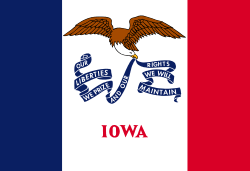
 Burlington, IA, United States
Burlington, IA, United States -
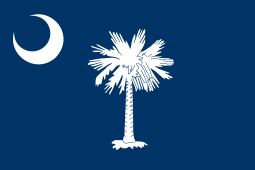
 Myrtle Beach, SC, United States
Myrtle Beach, SC, United States
See also
References
- 1 2 "Burlington, City Ontario (Census Subdivision)". Census profile, Canada 2011 Census. Statistics Canada. 8 February 2012. Retrieved 2012-02-24.
- ↑ "Arts & Entertainment" (PDF). Building Stories. Retrieved February 2015. Check date values in:
|access-date=(help) - ↑ Rayburn, Alan (1997). Place Names of Ontario. Toronto-Buffalo-London: University of Toronto Press. p. 48. ISBN 0-8020-7207-0.
- ↑ Halton: Rising, Wild and Beckoning. Conservation Halton. 1998.
- ↑ Reynolds, John Lawrence (June 1993). "Sounds by the Shore: A History of Burlington, Ontario, Canada". City of Burlington. Retrieved 2008-12-07.
- ↑ "Niagara Escarpment Commission: Flora & Fauna". Niagara Escarpment Commission. Retrieved 2009-03-21.
- ↑ "Burlington TS". Canadian Climate Normals 1981–2010. Environment Canada. Retrieved 2014-04-09.
- ↑ "Community Profiles from the 2006 Census, Statistics Canada - Census Subdivision". 2.statcan.ca. 6 December 2010. Retrieved 2011-03-10.
- ↑ "Ethnocultural Portrait of Canada - Data table". 2.statcan.ca. 6 October 2010. Retrieved 2011-03-10.
- ↑ "Community Profiles from the 2006 Census, Statistics Canada - Census Subdivision". 2.statcan.ca. 6 December 2010. Retrieved 2011-03-10.
- ↑
- ↑ Canadian Press (28 October 2012). "Long-form census cancellation taking toll on StatsCan data: Questions raised over how data can be used reliably". CBC News. Toronto: cbc.ca. Retrieved 2012-10-28.
- 1 2 Maxwell, Glynis (2005). "Burlington: Voices, Perspectives and Priorities" (PDF). Burlington ON Canada: Community Development Halton: 14.
- ↑ Reasons Why People Should Move to Burlington - Retrieved 23 July 2013
- ↑ Canadian Business Online. "Best places to live | Lists | MoneySense". List.moneysense.ca. Retrieved 2011-03-10.
- ↑ "BRONTE GREEN - ARGO". 2016-01-08. Retrieved 2016-08-09.
- ↑ "Burlington Downtown | What's Here". burlingtondowntown.ca. Retrieved 2016-08-09.
- ↑ "McMaster Coming to Burlington". City Talk. Spring 2009. p. 1.
- ↑ "CSU Ontario 5yr Celebration" (PDF). Retrieved 2010-07-06.
- ↑ "Canadian passenger train crash kills three in Ontario". BBC News. 27 February 2012.
- ↑ https://www.burlington.ca/en/your-city/resources/Elections/2014_Municipal_Election_Summary_Results_-_Official.pdf
- ↑ Leslie, Keith (2015-06-03). "Ontario getting 14 new MPPs to match federal ridings plus a bonus MPP in the North". National Post. Toronto: Postmedia Network. Retrieved 2015-11-11.
- ↑ "The Brant Street Pier". The City of Burlington. Retrieved 2013-10-02.
- ↑ "Art Gallery of Burlington Home Page". Retrieved 2015-12-14.
- ↑ Royal Canadian Naval Association Naval Memorial
- ↑ Burlington Public Art
- ↑ Hamilton Spectator
- ↑ "Appleby Ice Centre (City of Burlington)". Retrieved 2015-12-14.
- ↑ "Burlington Performing Arts Centre Home Page". Retrieved 2015-12-14.
- ↑ "Burlington Area Scouting Website". bu.scouter.ca. 27 February 2011. Retrieved 2011-03-10.
- ↑ "Tiger-Cats eye Burlington for stadium". InsideHalton Article. 27 December 2010. Retrieved 2011-03-10.
- ↑ "City of Burlington Website, Burlington International Games". Archived from the original on 1 September 2006.
External links
| Wikimedia Commons has media related to Burlington, Ontario. |
| Wikivoyage has a travel guide for Burlington, Ontario. |
 |
Milton | Oakville |  | |
| Hamilton | |
Lake Ontario | ||
| ||||
| | ||||
| Hamilton |
